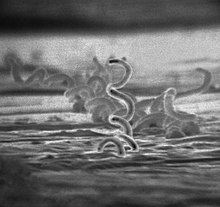T. pallidum
| Treponema pallidum | |
|---|---|
 |
|
| Scientific classification | |
| Domain: | Bacteria |
| Phylum: | Spirochaetes |
| Order: | Spirochaetales |
| Family: | Spirochaetaceae |
| Genus: | Treponema |
| Species: | T. pallidum |
| Binomial name | |
|
Treponema pallidum Schaudinn & Hoffmann, 1905 |
|
Treponema pallidum is a spirochaete bacterium with subspecies that cause treponemal diseases such as syphilis, bejel, pinta, and yaws. The treponemes have a cytoplasmic and an outer membrane. Using light microscopy, treponemes are visible only by using dark field illumination. They are Gram negative, but some regard them as too thin to be Gram stained.
At least four subspecies are known:
Some variation occurs as to which are considered subspecies, and which are species. The cause of pinta is sometimes described as Treponema carateum, rather than a subspecies of T. pallidum, even when the subspecies convention is used for the other agents.
This bacterium can be detected with special stains, such as the Dieterle stain. T. pallidum is also detected by serology, including nontreponemal VDRL, rapid plasma reagin, and treponemal antibody tests (FTA-ABS), T. pallidum immobilization reaction, and syphilis TPHA test). It was first microscopically identified in syphilitic chancres by Fritz Schaudinn and Erich Hoffmann at the Charité in Berlin in 1905
T. p. pallidum is a motile spirochaete that is generally acquired by close sexual contact, entering the host via breaches in squamous or columnar epithelium. The organism can also be transmitted to a fetus by transplacental passage during the later stages of pregnancy, giving rise to congenital syphilis. The helical structure of T. p. pallidum allows it to move in a corkscrew motion through mucous membranes or enter minuscule breaks in the skin. In women the initial lesion is usually on the labia, the walls of the vagina, or the cervix; in men it is on the shaft or glans of the penis. It gains access to the host's blood and lymph systems through tissue and mucous membranes.
...
Wikipedia
